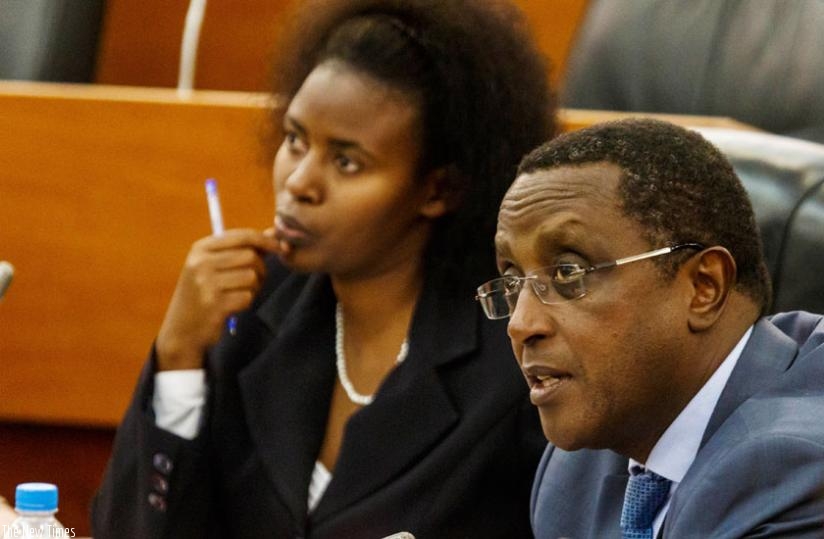Rwanda’s forestry coverage target of 30 per cent of the total surface area is to be met before the 2020 deadline as government turns focus to agro-forestry, Dr Vincent Biruta has said.


Rwanda’s forestry coverage target of 30 per cent of the total surface area is to be met before the 2020 deadline as government turns focus to agro-forestry, Dr Vincent Biruta has said.
Briefing a senatorial standing committee in charge of economic development and finance, on the status of forestry in the country, the Minister for Natural Resources said the country’s current forest coverage has so far reached 29.2 per cent from 25.9 per cent in 2010, with the target expected to be hit by 2018.
A ministry report shows that at least 4.7 percentage points were added to the country overall acreage in less than five years.
At least 714,102 hectares are expected to be entire forests reserves before the year 2020, from 694,402 hectares, it says.
Submitting the outcomes of the 2010 national forestry policy, Minister Biruta said, so far, the country managed to preserve five national forests of which the newly-gazetted Gishwati-Mukura Forest Reserve was added to Nyungwe, Akagera and Volcanoes.
Artificial forests so far cover 413,274 hectares, while natural and mostly thick forests sit on a surface of 245,242 hectares, but there are more 107 small size forests which cover a total of 37,886 hectares across the country, according to the minister.
Biruta further told senators that popular type of trees growing in those forests range from eucalyptus, estimated at 55 per cent of the total forests, followed by pinus, acacia, callitris, grevillea and cypress.
Streamlining of business projects was earlier envisaged in the national forestry policy depending on the systematic growth and the treatment of forest environment although, according to Biruta, the uptake of investments in the sector is still low.
"In seedling projects that involves planting and treating trees through community participation, partnership with a number of donors and joint programmes executed with the support of Rwanda Reserve Force managed to create 30,815 jobs,” he said.
So far, only one investor, the New Forest Company, has shown interest in the harvesting of Nyungwe belt reserve trees that extend up to 10,043 hectares after signing a contract with the government in 2011 to produce fine timber, charcoal for both local and outside markets.
Agro-forestry the magic bullet?
While the government awaits more investors to make use of other forest reserves in Gishwati-Mukura, the minister told The New Times that focus will now go into development of agro-forestry.
Agro-forestry programmes, which are well defined, in numerous strategies, will be worked on sustainably alongside national programmes of land consolidation and agricultural development plans within the country, he said.
The minister highlighted challenges for which senators called for immediate solutions to avoid possible retrogression on the achievements already registered.
Deforestation by woodland searchers and bricks manufacturers, illegal mining in the forests; parasites and diseases attacking trees, low enforcement of agro-forestry measures and low uptake of organised investments in the sector were cited among the challenges.
Senators called on the government to encourage more informative research, specifically on how to increase business prospects in the field, by assessing financial gains.
"The amount of money we spend on reforestation should be measured against how much we save in returns; there is a need to assess whether we don’t make any loss in the process,” said Senator Charles Uyisenga.
"We import a lot of furniture yet we also have raw materials in place that can be used to produce same end products.”
Senator Console Uwimana called for concerted efforts to control diseases.
"In case we don’t treat the reported disease and parasites that are ruining our trees, we can again lose 50 per cent of what we have already achieved, hence the need to protect registered achievements,” she said.
Reports from the forestry department at the Ministry of Natural Resources show that there was a loss of about 64 per cent of forests between 1960 and 2007, which is more than 1.3 per cent per year.
Senators said such losses need to be checked to beat the 2020 targets.
The rapid increase in population is also increasing pressure on forest cover in terms of encroachment and deforestation, requiring government to tighten strategies to prevent unpredictable seasonal disasters.
There is a dire need to plant more trees in deserted places, mostly those in eastern and western parts of the country.
*********************************
What is agroforestry?
Agroforestry or agro-sylviculture is a land use management system in which trees or shrubs are grown around or among crops or pastureland. It combines shrubs and trees in agricultural and forestry technologies to create more diverse, productive, profitable, healthy, and sustainable land-use systems.
The benefits created by agroforestry practices are both economic and environmental.
Agroforestry can increase farm profitability by increasing the total output per unit area of tree-crop-livestock combinations is greater than any single component alone. It ensures that crops and livestock are protected from the damaging effects of wind.
Agroforestry helps to conserve and protect natural resources by, for example, mitigating non-point source pollution, controlling soil erosion, and creating wildlife habitat.
editorial@newtimes.co.rw


